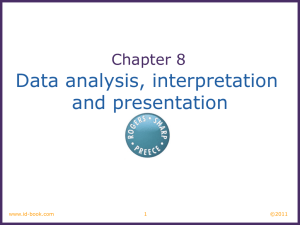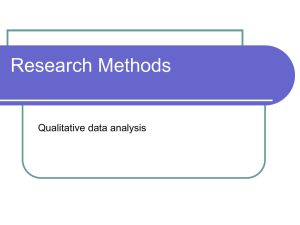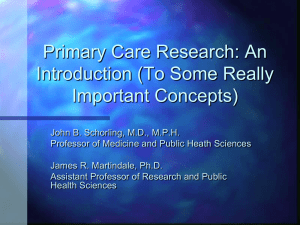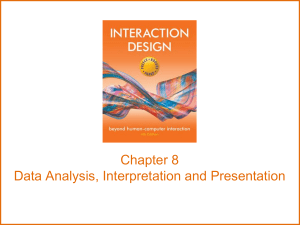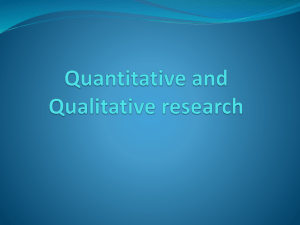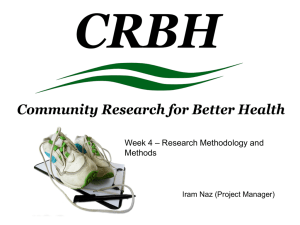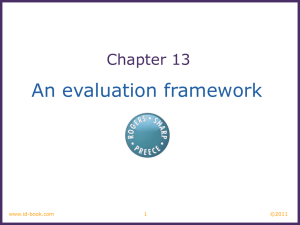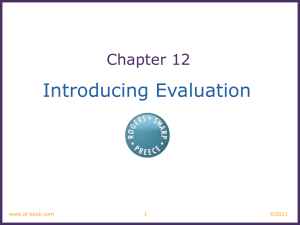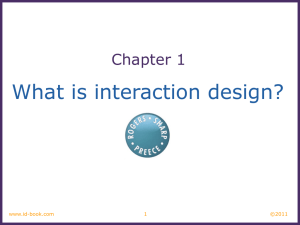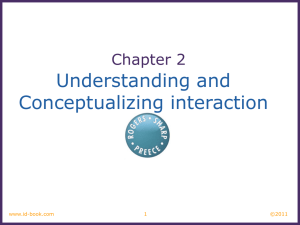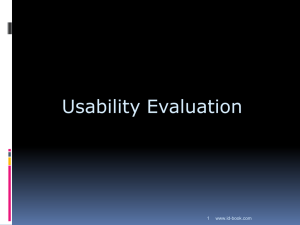Data analysis
advertisement
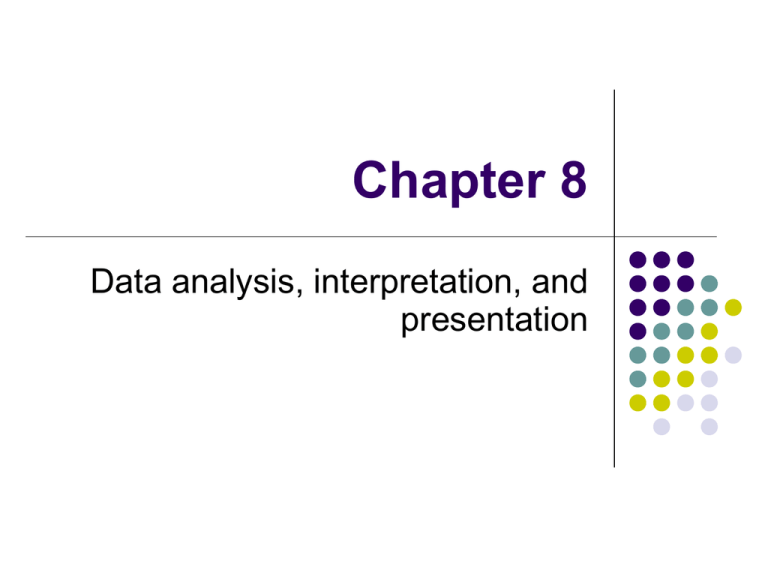
Chapter 8 Data analysis, interpretation, and presentation Outline Qualitative and quantitative Simple quantitative analysis Simple qualitative analysis Using theoretical frameworks Presenting the findings Qualitative and quantitative Quantitative data is data that is in the form of numbers, or that can easily be translated into numbers Examples: number of years of work experience, number of projects, number of minutes to carry out a task Qualitative and quantitative Qualitative data is data that is difficult to measure, count, or express in numerical terms that make sense Qualitative and quantitative All the forms of data gathering discussed in previous chapter may result in qualitative and quantitative data Examples: on a questionnaire participants’ age or number of software packages used are quantitative data comments are qualitative data Data analysis First steps in analyzing data Interviews Questionnaires data transcription, finding categories or patterns of response data cleansing, data filtering (subsets of data) Observations Notes write-up, data transcription, synchronization between different data recordings Data analysis Simple quantitative analysis Averages Mean (ค่าเฉลี่ย) Median (มัธยฐาน) Mode (ฐานนิยม) Percentages Data collation (Excel) Finding out outliers Finding out patterns (graphical representation) Simple qualitative analysis Unstructured - are not directed by a script. Rich but not replicable. Structured - are tightly scripted, often like a questionnaire. Replicable but may lack richness. Semi-structured - guided by a script but interesting issues can be explored in more depth. Can provide a good balance between richness and replicability. From: www.id-book.com Data analysis Simple qualitative analysis Identifying recurring patterns or themes Categorizing data Analyzing critical incidents Data analysis Simple qualitative analysis Identifying recurring patterns or themes Study goals provide an orienting focus for the formulation of themes A balance between generalness and specificity Relate to various aspects, e.g., to behavior, to user group, to places and situations Data analysis Simple qualitative analysis Categorizing data The data is divided up into elements and each element is then categorized The categorization scheme may arise from the data itself, or it might originate elsewhere in a wellrecognized categorization scheme, or a combination of these two approaches The goal of the study largely determines which categories to use Data analysis Simple qualitative analysis Categorizing data The challenging aspects are 1) determining meaningful categories that are not overlap each other in any way 2) deciding on the appropriate granularity for the categories, e.g. at word, phrase, sentence, or paragraph level The categorization scheme used must be reliable -> inter-rater reliability Data analysis Simple qualitative analysis Categorizing data Content analysis involves categorizing the data and then studying the frequency of category occurrences Discourse analysis focuses on the dialog, i.e. the meaning of what is said, and how words are used to convey meaning Conversation analysis focuses on how conversation is conducted, i.e. how conversation starts, how turn-taking is structured, and other rules of conversations Data analysis Simple qualitative analysis Analyzing critical incidents Two basic principles 1) reporting facts regarding behavior is preferable to the collection of interpretations, ratings, and opinions based on general impressions -> well-planned observation sessions 2) reporting should be limited to those behaviors which, according to competent observers, make a significant contributions to the activity in either desirable or an undesirable way Using theoretical frameworks Grounded theory Distributed cognition Activity theory Grounded theory The theory derived is grounded in the data The aim is to develop a theory that fits a set of collected data In this context, theory means ‘a set of welldeveloped concepts related through statements of relationship, which together constitute an integrated framework that can be used to explain or predict phenomena’ (Strauss & Corbin, 1998) Grounded theory Development of a ‘grounded’ theory progresses through alternating data collection and data analysis Data gathering is driven by the emerging theory This approach continues until no new insights emerge and the theory is well-developed Grounded theory Researchers need to maintain a balance between objectivity and sensitivity Objectivity is needed to maintain accurate and impartial interpretation of events Sensitivity is required to notice the subtleties in the data and identify relationships between concepts Grounded theory Main idea is to identify and define the properties and dimensions of relevant categories and then to use these as the basis for constructing a theory Category identification and definition is achieved by ‘coding’ the data Grounded Theory Three levels of ‘coding’ Open: identify categories Axial: flesh out and link to subcategories Selective: form theoretical scheme Grounded Theory Questioning Analysis of a word, phrase, or sentence Comparisons Researchers are encouraged to draw on own theoretical backgrounds to inform analysis Distributed Cognition The people, environment & artifacts are regarded as one cognitive system Used for analyzing collaborative work Focuses on information propagation & transformation From: www.id-book.com Distributed Cognition Results in an event-driven description which emphasizes information and its propagation through the cognitive system under study The granularity of analysis varies depending on the activities and cognitive system being observed and the research or design questions being asked Distributed Cognition Ed Hutchins emphasizes that an important part of doing a distributed cognition analysis is to have a deep understanding of the work domain that is being studied There is no single way of doing a distributed cognition analysis Distributed Cognition A good way to begin analyzing and interpreting the data collected is to describe the official work practices Any breakdowns, incidents, or unusual happenings should be highlighted While writing these observations down, it is good to start posing specific research questions related to them and contemplate further Distributed Cognition Problems can be described in terms of the communication pathways that are being hindered or the breakdowns arising due to information not propagating effectively from one representational state to another Distributed Cognition It can show when different technologies and the representations displayed via them are effective at mediating certain work activities and how well they are coordinated Concepts: Cognitive system Communicative pathways Propagation of representational states Activity Theory Explains human behavior in terms of our practical activity with the world Provides a framework that focuses analysis around the concept of an ‘activity’ and helps to identify tensions between the different elements of the system Two key models: one outlines what constitutes an ‘activity’; one models the mediating role of artifacts Individual model From: www.id-book.com Individual model Operations – routinized behaviors that require little conscious attention, e.g. rapid typing Actions – behavior that is characterized by conscious planning, e.g. producing a glossary Activity – provides a minimum meaningful context for understanding the individual actions, e.g. writing an essay Individual model There may be many different operations capable of fulfilling an action Many actions capable of serving the same activity Individual model There is an intimate and fluid link between levels Actions can become operations as they become more automatic Operations can become actions when an operation encounters an obstacle, thus requiring conscious planning Individual model If ‘motive’ changes then an activity can become an action Activities relate to others while actions may be part of different activities The role of artifacts Artifacts can be physical, e.g. A book A stone Artifacts can be abstract, e.g. A system of symbols A set of rules Engeström’s (1999) activity system model From: www.id-book.com Presenting the findings Only make claims that your data can support The best way to present your findings depends on the audience, the purpose, and the data gathering and analysis undertaken Graphical representations may be appropriate for presentation From: www.id-book.com Presenting the findings Other techniques are: Rigorous (clear syntax and semantics) notations, e.g. UML Using stories, e.g. to create scenarios Summarizing the findings From: www.id-book.com Summary The data analysis that can be done depends on the data gathering that was done Qualitative and quantitative data may be gathered from any of the three main data gathering approaches Percentages and averages are commonly used in Interaction Design Summary Mean, median and mode are different kinds of ‘average’ and can have very different answers for the same set of data Grounded Theory, Distributed Cognition and Activity Theory are theoretical frameworks to support data analysis Presentation of the findings should not overstate the evidence Chapter Review Chapter 1-7 Chapter 1 What is interaction design? Interaction Designer vs. Software Engineers User experience Usability goals Effectiveness (ประสิ ทธิ ผล) Efficiency (ประสิ ทธิ ภาพ) Safety Utility Learnability Memorability Chapter 1 Usability Criteria Norman’s Design Principles Visibility Feedback Constraints Consistency Affordances Chapter 2 Understanding the problem space Are there problems with an existing product or user experience? If so, what are they? Why do you think there are problems? How do you think your proposed design ideas might overcome these? If you have not identified any problems and instead are designing for a new user experience, how do you think your proposed design ideas support, change, or extend current ways of doing things? Chapter 2 Conceptual model Metaphors and analogies Concepts: task-domain objects, objects’ attributes, operations performed on objects Relationships between concepts Mappings between concepts and task-domain the system is designed to support Chapter 2 Interface metaphors Interaction Types Instructing Conversing Manipulating Exploring Chapter 3 Users’ cognition Attention Perception and recognition Memory Learning Reading, speaking, and listening Problem-solving, planning, reasoning, decisionmaking Chapter 3 Cognitive frameworks Mental models Theory of action Information processing External cognition Distributed cognition Chapter 4 Social mechanisms in communication and collaboration Conversational mechanisms Coordination mechanisms Awareness mechanisms Chapter 5 Affective aspects User frustration Sources of user frustration, e.g. error messages, appearance Persuasive technologies Anthropomorphism in interaction design, i.e. virtual agents Chapter 6 Interface types Command interfaces WIMP/GUI interfaces Advanced graphical interfaces Web-based interfaces Speech interfaces Mobile interfaces Chapter 7 Data gathering Interviews Questionnaires Observation




